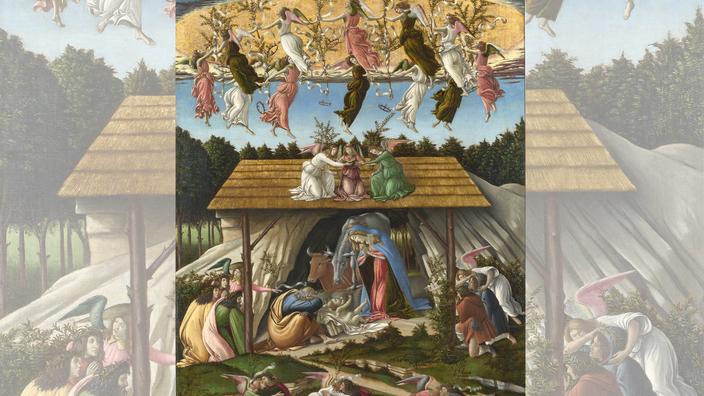“
I, Alessandro, painted this picture at the end of the year 1500 during the troubles in Italy, when the eleventh chapter of Saint John was accomplished in the second grief of the Apocalypse, during the three years and half of the liberation of the devil who will then be chained in the 12th chapter.
Then we will see it precipitated underground as in this painting.
The Florentine year beginning on the day of the Annunciation, it is therefore shortly before March 25, 1501 that Botticelli inscribes these mysterious sentences in ancient Greek, at the top of his
mystical Nativity
.
Read alsoBotticelli, itinerary of a child prodigy: at the origin of genius
In Florence, it's like history repeating itself. The King of France Louis XII has just entered Italy on his march towards Milan. It is also said that Caesar Borgia, son of Pope Alexander VI, entered Romagna. It does not take more to terrorize the inhabitants of a city where the prophecies of Savonarola still resound. Sandro himself, this time, has difficulty resisting the anguish. A radical change has taken place in the artist since the execution of the prior of San Marco. He saw the persecutors become the persecuted. Her brother Simone had to flee to Bologna to avoid torture. And then he spoke with Doffo Spini, one of those responsible for the hanging of Savonarola: "
Am I telling you the truth, Sandro?" We did not find him the least mortal sin, nor even venial.
"
The judges condemned him so as not to fall prey to an enraged mob themselves. While rummaging in his brother's library, Sandro found a few pamphlets that he read eagerly. This reading upset him: “
Do you believe that the Virgin came out dressed as you painted her? I tell you that she dressed poorly. And you dressed her in the garb of a whore! Into what decadence has therefore fallen the veneration of God!
Words that could not fail to impress the painter for a long time. He thinks of his Virgin of the Magnificat all adorned with gilding, of his Virgin with the pomegranate with her dreamy face similar to that of Venus emerging from the wave. He sees in all of this the mark of sin.
His very style came out of this crisis altered. The simple pressure of a hand on a piece of cloth, the pleating of a veil, the exquisite grace of a pose, all that which once occupied him suddenly no longer has its place. In his mystical Nativity, the angels on earth embracing the shepherds, the angels in the sky carried away in their round, the angels posed on the roof of the manger, give the work a shocked rhythm. As if the characters of Sandro had suddenly woken up from their dreams and were nothing more than energy, tension, intoxication of tall bodies stretched out with mannerist gestures.
The painter is now fifty-five years old. Like Donatello before him, or Michelangelo afterwards, he abandons the full and harmonious forms of his young age, to favor the expression of emotions, the pure play of lines on the canvas. In this hermetic work, Botticelli gives free rein to his sympathies for Savonarola. The inscription in Greek thus refers to the favorite book of the Dominican monk. In the eleventh chapter of Revelation, which Sandro thinks he is living, Saint John describes the death of the two prophets of God, their abduction in the clouds. In the 12th chapter, which the painting is supposed to depict, a woman appears, crowned with twelve stars, and crushes the fallen Dragon under her feet. Sandro is quite clear: for him, the two witnesses are Savonarola and his disciple Domenico da Pescia,carried to heaven in the smoke of the pyre.
As for the Woman, a long tradition sees in her the symbol of the Church.
The Virgin adoring the Child is therefore also the Woman of the Apocalypse: this is why demons flee under the earth, this is why angels, in the empyrean, let twelve crowns hang above the earth. crib.
The end of Satan, for the painter, must pass through a Nativity which is also a rebirth, that of a renovated Church.
“
Me, Alessandro.
For the only time in his life, Sandro signs one of his paintings.
But it's more than a signature.
It sounds like an act of faith, the moving expression of the hopes of an old man on the eve of life.
Botticelli, all the beauty in the world, € 12.90 on Figaro Store
Cover of the Figaro Hors-Série dedicated to Botticelli La Belle Simonetta, Botticelli, 1485 (Städel Museum)

